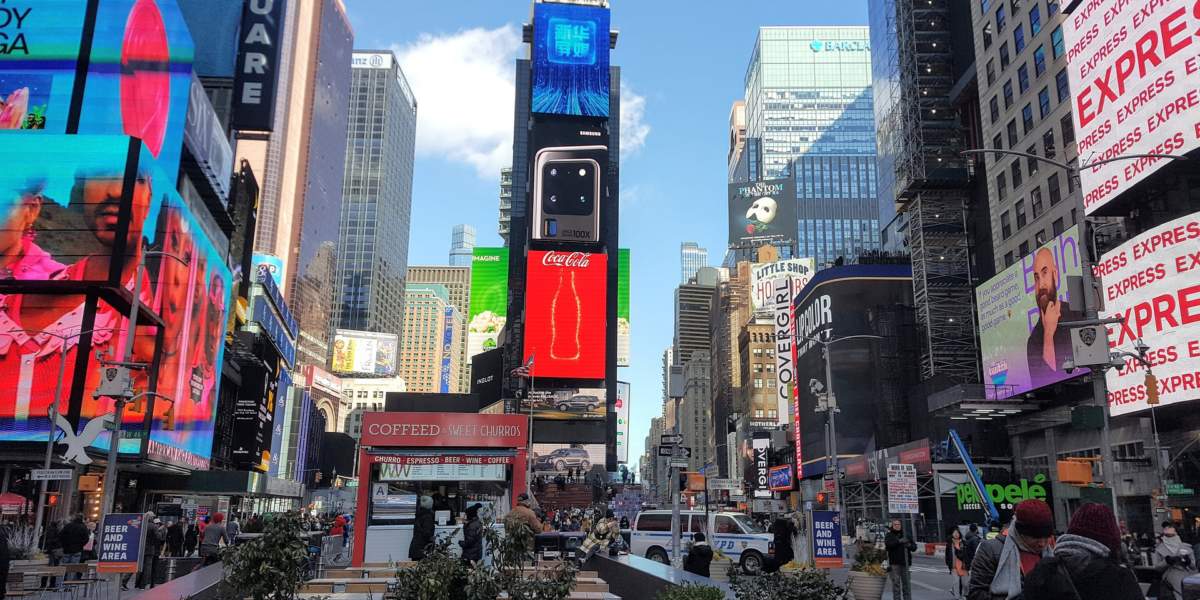Many people seem to believe that the power of billboards pales in comparison to digital, social, and television advertising—but that’s simply not the case. Read on to learn the realities of common myths about billboards and other out-of-home media.
MYTH: Billboards can’t target audiences.
REALITY: The purpose of billboards is to target by location, demographics, and lifestyle.
Out-of-home (OOH) targeting works pretty much the same as it does online: when you know the audience you want to target, you can find out where that audience lives and works. Then, you can place billboards where they’re likely to pass by them (sometimes multiple times a day).
Place-based media—for example, ads on shopping carts, on restaurant tables, or in bus shelters—are another form of out-of-home advertising that have targeting based on lifestyle and habits built right in. By appearing to the ideal consumer where they already are, place-based ads avoid the trap many novice marketers fall into: wasting money broadcasting their message to people who will never be interested.
MYTH: Billboards don’t offer tracking.
REALITY: There are several ways to measure the effectiveness of billboards.
Living in a digitally-connected world means that measuring the effectiveness of billboard advertising is easier than ever. Technological advancements like beacons and shadowfencing have made it possible to display retargeted digital ads on phones that have passed a billboard. There are even methods of tracking to determine whether someone bought a product after seeing a billboard for it!
Knowing the amount you’re investing in your advertising vs. how much you’re earning from it is vital. Companies like GeoPath and Clear Channel offer ways to calculate impression costs, helping you stay informed about your budget decisions. So, if someone tries to tell you that billboards are a waste of advertising dollars because you can’t track their success, remind them that tracking and measurement can be performed on phones, cars, and footfall—and even eyes.
MYTH: People ignore billboards.
REALITY: Billboards draw attention.
While it’s true that people can ignore billboards, it’s also true that people have grown accustomed to tuning out other forms of advertising just as much—if not more. They install AdBlock on their computers, go to the bathroom during commercial breaks, and avoid pop-up ads like the plague.
Billboards, on the other hand, have no commercial breaks. There aren’t apps designed to block them. And they can’t be scrolled away from. Billboards—and other place-based ads like those found in grocery stores and gas stations—are always around to be seen.
Another bonus about billboards? They’re not as intrusive as other forms of advertising: people expect to see them as they travel. Yes, we expect to see digital ads, too—but those ads while we’re browsing social media, shopping, or reading the news are often an annoying disruption rather than a welcome break for our eyes on the highway.
MYTH: Billboards are boring and old-fashioned.
REALITY: Billboards are only limited by your imagination.
Just because billboards have been around for a century doesn’t mean they have to be dull. Billboards have evolved: today, they are digitized (i.e., easy to update), interactive (i.e., drivers of engagement), and aesthetically-driven (i.e., designed for sharing on social media, which we’ll get into below).
People are so invested in their phones now that they’re perfectly accustomed to tuning out the digital ads that appear on their favorite social media platforms, the articles they read, and the browsing they do. Out-of-home advertising, on the other hand, is more likely to be seen by someone who isn’t on their phone.
Drivers, travelers, shoppers, and even event-goers don’t typically have their nose in their phones. Instead, they’re alert and looking around, taking in their environment…which includes billboards and other out-of-home ads. That’s why it pays to have creative billboards: the more interesting they are, the more likely it is that they’ll be remembered.
MYTH: Billboards don’t have any effect on people.
REALITY: Billboards are great at driving online activity.
In 2017, Nielsen discovered that “outdoor advertising is the most effective nondigital medium for generating online activity.” Translation? A consumer who has passed a billboard—whether in the car, on the bus, or on foot—is likely to go online and conduct a search (or perform another action) on their phone. These actions can range from getting directions to a restaurant to following a social media page or signing up to learn more info.
This is why online tech companies like Facebook, Netflix, and Amazon invest in out-of-home advertising: even they have to reach offline audiences somehow! Generating online engagement from offline audiences is a huge part of omnichannel marketing, which makes billboards effective pieces of integrated marketing campaigns.
Plus, billboards and other out-of-home creative can be shared on social media, giving them extra longevity and engagement. Consider:
Know what looks great on Instagram? A really cool wall mural on the way to Coachella. Rotting zombie fingers in a train station. A light bulb that lights up when you walk under it. Know what doesn’t play well on Instagram? A screenshot of a banner ad. Audio from a radio spot.”
Gino Sesto, Founder of DASH TWO
When you produce an out-of-home experience that people want to interact with and share, you create a lasting impression that can draw attention even when it’s long gone.
MYTH: It’s hard to get started with billboard advertising.
REALITY: Kirkpatrick Creative can help your out-of-home ad strategy.
Now that you know the truth about billboards, it’s time to start integrating out-of-home into your marketing. An experienced advertising agency can help you develop the perfect omnichannel strategy to meet your goals.
At Kirkpatrick Creative, we don’t just make great creative—we measure the effectiveness of everything we do to ensure that every dollar of your advertising budget pulls its weight. It’s what we call advertising engineered to work.
Ready to start setting up your out-of-home campaign? Get in touch with us!

